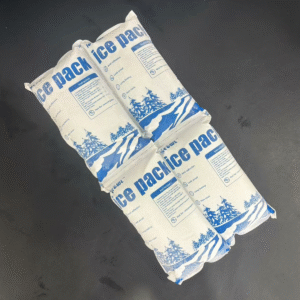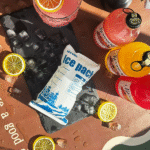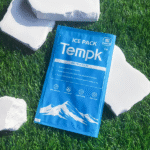Es kering, yang merupakan karbon dioksida padat, menawarkan kemampuan pendinginan yang kuat. Namun, its sublimation—where it turns directly from solid to gas—can result in its rapid disappearance if not properly insulated. Proper insulation reduces heat transfer, ensuring dry ice remains effective for longer. Whether you’re storing dry ice for an event, shipping perishable items, or conducting scientific experiments, this guide provides proven methods for keeping your dry ice cold.
-
How can you best insulate dry ice for long-term storage?
-
What materials are most effective for keeping dry ice cold?
-
How can you prevent dry ice from sublimating too quickly?
-
Practical tips to maintain dry ice temperature in different environments.
Why Insulate Dry Ice?
Dry ice sublimates when exposed to heat, which means it turns from a solid directly into carbon dioxide gas. Insulating dry ice reduces the heat entering the container, slowing this sublimation process and extending its life. Effective insulation also ensures safety by preventing dangerous pressure build-up and maintaining the required low temperatures for your goods or experiments.
Best Materials for Insulating Dry Ice
To maximize the effectiveness of dry ice insulation, the choice of materials is key. Here are the most common and effective materials used:
-
Styrofoam (EPS): Polystyrene yang diperluas (EPS) is a popular material for short-term and medium-term dry ice storage due to its excellent insulating properties.
-
Kotak pengiriman terisolasi: These often feature Styrofoam or polyurethane layers and are designed specifically for shipping dry ice, helping it stay cold for up to five days.
-
Coolers with Thick Insulation: A thick-walled cooler combined with additional insulating materials like foam sheets or gel packs can greatly reduce sublimation.
-
Aerogel: A highly advanced material with exceptional insulation properties, often used in specialized, high-performance applications.
How to Store Dry Ice in Insulated Containers
Proper storage is crucial for keeping dry ice cold. Here are some essential tips:
-
Ventilated Container: Dry ice needs ventilation to safely sublimate. Always choose a container with vents or air holes. Hindari wadah kedap udara, as the pressure from the CO₂ gas can cause them to rupture.
-
Bungkus Es Kering: Wrap the dry ice in materials like bubble wrap, foam sheets, or even newspaper. This provides an extra layer of insulation and slows the sublimation process.
-
Use Multiple Layers: Combine Styrofoam, a thick cooler, and cloth layers for enhanced insulation. This helps keep dry ice cold longer, Terutama di lingkungan yang lebih hangat.
Untuk tipnya:
Ensure proper ventilation in the storage container. Too much insulation without ventilation can create dangerous conditions, as pressure from the sublimating CO₂ gas may cause an explosion.
Insulating Dry Ice for Short-Term Use
For short periods (a few hours), you can use a simple Styrofoam box or a cooler with thick insulation. These methods work well for transporting small quantities of dry ice or for keeping items cold during an event. Namun, remember that even with proper insulation, dry ice needs ventilation.
Insulating Dry Ice for Long-Term Storage
For storage periods exceeding several hours, it’s essential to use high-quality insulated shipping boxes or coolers. Here are some suggestions based on your needs:
-
Kotak Styrofoam: Ideal for short-term use (1–2 hari) and small quantities of dry ice.
-
Pendingin Terisolasi: Great for long-term storage (up to 3–5 days), especially if sealed properly and used with additional insulation materials.
-
Vacuum-Insulated Panels: Used in professional shipping containers for extended durations, keeping dry ice solid for several days.
| Bahan | Efektivitas | Kasus penggunaan yang ideal | Tips Praktis |
|---|---|---|---|
| Styrofoam | Tinggi | Penyimpanan jangka pendek | Use for 1-2 days for small shipments |
| Pendingin Terisolasi | Sangat tinggi | Penyimpanan jangka panjang | Best for shipping or extended use |
| Aerogel | Luar biasa | High-performance cooling | Use for specialized applications |
| Vacuum-Insulated Panels | Sangat tinggi | Extended storage or shipping | Best for shipping large quantities |
Preventing Dry Ice from Sublimating Too Quickly
The rate of sublimation is largely controlled by the ambient temperature and the insulation’s effectiveness. Here are practical ways to slow the process:
-
Store Dry Ice in a Cool Place: Avoid direct sunlight and high ambient temperatures, as these accelerate sublimation.
-
Use Multiple Layers of Insulation: The more insulation you use, the slower the sublimation. Always aim for at least two layers—such as Styrofoam and a cooler.
-
Minimize Opening the Container: Each time you open the container, udara hangat masuk, yang mempercepat sublimasi. Open it only when necessary.
How Long Can Dry Ice Stay Cold with Proper Insulation?
Dry ice can remain cold for several hours to days, depending on factors like the type of insulation, the volume of dry ice, and the container’s size.
-
With Styrofoam: Es kering dapat bertahan hingga 24 jam, tergantung pada jumlah yang digunakan.
-
With Insulated Coolers: Dry ice can stay cold for 2-3 days if the cooler is sealed properly and insulated.
The Role of Ventilation in Dry Ice Insulation
Ventilation is crucial to safe dry ice storage. gas CO₂, released during sublimation, can accumulate and displace oxygen, menyebabkan risiko mati lemas. Ensure your container has small vents or openings to allow the gas to escape safely.
What to Avoid When Insulating Dry Ice
Here are some common mistakes to avoid:
-
Airtight Containers: Never store dry ice in airtight boxes or glass bottles. The pressure from sublimating gas can cause explosions.
-
Tipis, Insufficient Insulation: Thin materials or containers with poor insulation allow heat to transfer more easily, increasing sublimation rates.
Risks of Poor Insulation
Improper insulation can lead to several risks, seperti:
-
Mati lemas: In confined spaces with poor ventilation, CO₂ gas may displace oxygen, creating suffocation hazards.
-
Radang dingin: Contact with dry ice can cause severe skin damage. Always handle it with insulated gloves.
-
Ledakan: Sealing dry ice in airtight containers can cause a dangerous buildup of gas pressure, menyebabkan ledakan.
Cara Menangani Es Kering dengan Aman
Saat menangani es kering, ikuti pedoman ini:
-
Use Protective Gear: Always wear insulated gloves or tongs to prevent frostbite.
-
Ventilated Areas: Store and handle dry ice in well-ventilated areas to allow CO₂ to dissipate.
-
Keep Dry Ice Away from Children and Pets: The risks associated with dry ice, including frostbite and asphyxiation, are particularly dangerous in areas where children or pets can access it.
Studi kasus: Safe Dry Ice Handling
A laboratory technician transported 20 lb of dry ice for a 4-hour trip using an insulated cooler. By wearing insulated gloves and ensuring proper ventilation, the technician successfully avoided both frostbite and asphyxiation risks.
2025 Trends in Dry Ice Insulation and Usage
As dry ice storage technologies evolve, several trends are emerging in 2025:
-
Wadah yang dapat digunakan kembali: More companies are turning to reusable insulated containers to reduce waste and improve efficiency.
-
Pemantauan Suhu Cerdas: IoT-enabled containers are now capable of tracking temperature and location, ensuring optimal dry ice preservation during shipping.
-
Isolasi Ramah Lingkungan: The use of biodegradable insulation materials, such as plant-based foams, is on the rise as businesses look for greener solutions.
Kesimpulan dan Rekomendasi
To maximize dry ice preservation, use the right insulation materials like Styrofoam or insulated coolers, and ensure your containers are well-ventilated. Avoid airtight containers to prevent dangerous pressure buildup. As new technologies like smart sensors and reusable containers emerge, staying updated on best practices can significantly enhance your cold chain operations.
Langkah Tindakan:
-
Pilih wadah yang tepat: Based on the duration and type of goods being stored or shipped, select a container with appropriate insulation.
-
Pastikan ventilasi yang tepat: Always allow for gas release to avoid pressure buildup.
-
Menangani dengan hati -hati: Use gloves and store in well-ventilated areas to avoid frostbite and suffocation hazards.
Tentang tempk
Tempk specializes in temperature-controlled logistics, offering innovative solutions for dry ice insulation and storage. Our advanced packaging materials and temperature tracking systems ensure your products are preserved with the utmost care.
Hubungi kami hari ini to discuss your dry ice needs or explore our customizable shipping solutions.
























